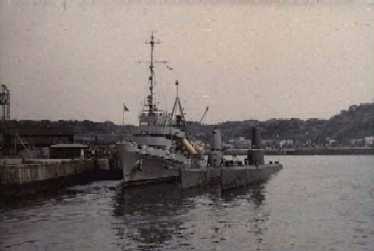
I reported aboard the USS Sterlet in San Diego harbor in 1954 as they needed a senior ET for their scheduled cruise to WesPac. Before heading for WesPac the Sterlet pulled into Pearl Harbor and established a presence. Upon returning from WesPac the Sterlet remained stationed at Pearl Harbor. It was on the Sterlet that I got to visit Taiwan(Formosa) and Hong Kong (BCC). (See Other Places)
The Sterlet had been converted to snorkel but the deck and bow had not been reconfigured. As a result we had to snorkel with a constant down angle to counter the lift effect of the bow shape, a condition which made it difficult for the planesmen at the higher speed.
In Yokosuka, Japan, The Sterlet paired up with the Ronquil for many of the exercises.
The Sterlet and Ronquil moored outboard of the ASR in Yokosuka harbor.
One of the more unusual places we visited on our WesPac tour was Chi Chi Jima, a Japanese fortified island 100 miles east of the main Japanese island of Honshu. During the later part of the war, this island was in the process of being developed as the last stand for the Emperor. For anyone still dreaming that the Japanese mainland would have gone down without a costly battle, this island is a symbol of the determination to fight to the last man. Strange that it never was so publicized in the arguments about using the A-bombs. Check "Other Places" for details.
In Keelung, Formosa, our captain, LT Gilmore, welcomed a Chinese admiral aboard for an inspection. It was all quite informal as befitting a submarine crew.
In Kaoshung, Formosa, we tied up alongside the dock and the Ronquil moored outboard of us. Apparently we had only been assigned 300 feet of dock space. Each night, when we set up the movie projector on the dock and hung the screen on the side of the sail we attracted quite a crowd of locals.
I left the Sterlet in 1956 after it had returned to Pearl Harbor and was in the Pearl Harbor Navy Yard for refit and to have the bulbous sonar nose installed. I left before the nose was completely built, but watched all the foundation being constructed. I could see it would have looked like the Bluegill. I left to take advantage of the Korean GI Bill college program which would have expired within the next few years. I had been offered for my next duty station shore duty as station chief at the Annapolis Naval Academy radio station, but I opted for another career.
I got my BSEE from Penn State in 1960, then moved to California, to that area that became known as "Silicon Valley." I have been involved with the design and manufacture of semiconductor devices and integrated circuits for 40 years. I have now been retired for 20 years in the foothills of California.